
Affordable, high-end drones coupled with easy-to-use mission-planning tools, created the perfect environment for drones to flourish.
No longer the preserve of specialists, applications using drones have ventured into survey, inspection and volume analysis.
The impact of drones is little short of revolutionary.
But, in the air, the stakes are higher. When things go wrong, the consequences are invariably much more serious than for a ground-based application. One of the biggest threats to drone safety is GNSS interference.
At the very least, disruptions to satellite signals can degrade position quality. When this occurs it causes fall-backs from high-precision RTK and PPP modes to less-precise modes. In the most extreme cases, interference can result in complete loss of signal tracking and positioning.
Self interference
Other components installed on a UAV is often a significant source of interference. The restricted space often means that the GNSS antenna is in close proximity to other electrical and electronic systems.
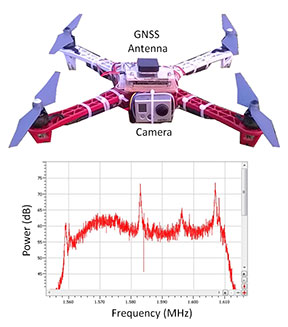
Figure 1 shows what happened to the GPS L1-band spectrum when a GoPro camera was installed on a quadcopter close to the GNSS antenna without sufficient shielding. The three peaks are exactly 24 MHz apart. This points to their being harmonics of a 24 MHz signal: the typical frequency for a MMC/SD logging interface.
An AsteRx4 receiver, which includes the AIM+ system, was selected for this setup. As well as mitigating the effects of interference, AIM+ includes a spectrum plot to view the RF input from the antenna in both time and frequency domains.
At the installation stage, the ability to view the RF spectrum is an invaluable tool for identifying the source of interference. Plus, it helps with determining the effectiveness of measures such as modifying the setup or adding shielding.
For the quadcopter installation in this example, the loss of RTK was readily diagnosed. The problem was solved by placing the camera in a shielded case. All this while the quadcopter was still in the workshop.
External sources of interference
GNSS receivers on-board UAVs can be particularly vulnerable to external sources of interference, be they intentional or not. In the sky, the signals from jammers can propagate over far longer distances than they would on land.
In the case of UAV inspections of wind turbines for example, many countries encourage the construction of windmills next to roads. However, this situation increases the chance of interference from in-car chirp jammers.
Though illegal, chirp devices are cheap and readily available on the internet. For example, an individual using a chirp jammer can drive around undetected by the GPS trackers on the vehicle. Car thieves can disable GPS anti-theft devices on stolen vehicles with chirp jammers.
External interference: the effect of a chirp jammer on a UAV flight
Although transmitting with a power of around 10 mW, chirp jammers are powerful enough to knock out GNSS signals in a radius of several hundred meters on land. In the air, unhindered by trees, building or other obstacles, these jamming signals have a far greater reach. Thus, the UAV is much more vulnerable to interference.

Figure 2 shows how a 10mW chirp jammer can knock out RTK positioning over more than 1 km in a high-end receiver.
Even a low-end consumer-grade L1 receiver, being less accurate and thus less sensitive, loses stand-alone positioning over several hundred meters.
With AIM+ activated, the AsteRx4 is able to maintain an RTK fix throughout the simulated flight. It also shows no degradation to its position variance.
Solving chip-jammer interference on UAV systems
A comprehensive approach puts interference considerations at the forefront of receiver design and incorporates it into every stage of signal processing. In the case of the
AsteRx4 and
AsteRx-m2, the antenna signal is immediately digitized after analogue filtering and automatically cleansed of interference using multiple adaptive filtering stages.
As each interfering signal has its own individual footprint, the ability to visualize the RF signal in both time and frequency domains allows drone users to identify sources of self-jamming and adapt their designs accordingly before the drone gets in the air.
When it is in the air, AIM+ is able to mitigate jamming from external sources: a set of configurable notch filters are complemented by an adaptive wide-band filter capable of rejecting more complex types of interference such as that from chirp jammers, frequency-hopping signals from DME/TACAN devices as well as high-powered Inmarsat transmitters.
You can
shop Septentrio's line of solutions at Unmanned Systems Source.
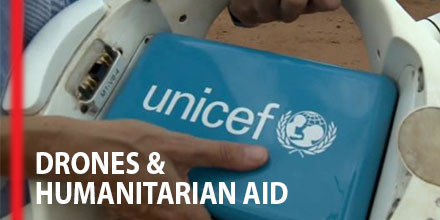 Industry is not the only sector moving towards the rapid adoption of drones for operations. In fact, a growing number of non-profit organizations are beginning to test the feasibility of drones for their work.
Recently, the Malawi Government and the United Nations International Children’s Emergency Fund (UNICEF) announced the launch of a unique testing corridor.
The corridor's purpose is to test the effectiveness of delivering humanitarian aid via drone.
A first of its kind in Africa, the Humanitarian UAV Testing Corridor launched in June.
Today, it is fairly common to use drones for search and rescue efforts as well to capture live images of inaccessible disaster zones. But, many believe that's just the beginning.
Given the vast area and various issues plaguing the continent, technology can play an important part in Africa's development and growth. The continents launch of humanitarian drones may very well turn out to be the vanguard in helping to tackle some of those problems.
“This humanitarian drone testing corridor can significantly improve our efficiency and ability to deliver services to the world's most vulnerable children,” Christopher Fabian, UNICEF Office of Global Innovation Principal Adviser said in reference to the program in Malawi.
Industry is not the only sector moving towards the rapid adoption of drones for operations. In fact, a growing number of non-profit organizations are beginning to test the feasibility of drones for their work.
Recently, the Malawi Government and the United Nations International Children’s Emergency Fund (UNICEF) announced the launch of a unique testing corridor.
The corridor's purpose is to test the effectiveness of delivering humanitarian aid via drone.
A first of its kind in Africa, the Humanitarian UAV Testing Corridor launched in June.
Today, it is fairly common to use drones for search and rescue efforts as well to capture live images of inaccessible disaster zones. But, many believe that's just the beginning.
Given the vast area and various issues plaguing the continent, technology can play an important part in Africa's development and growth. The continents launch of humanitarian drones may very well turn out to be the vanguard in helping to tackle some of those problems.
“This humanitarian drone testing corridor can significantly improve our efficiency and ability to deliver services to the world's most vulnerable children,” Christopher Fabian, UNICEF Office of Global Innovation Principal Adviser said in reference to the program in Malawi.

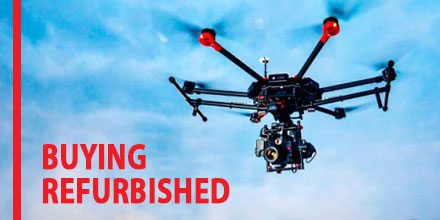 Smart phones, game consoles, smart TVs...and now, drones.
New technology is exciting but the cost of owning the latest gadgets prevent many from immediately running out and buying it. Many wait months before purchasing coveted products in the hopes that competition may eventually drive the price down.
However, some savvy shoppers choose another path...refurbished products.
From smartphones games consoles, refurbished electronics are a viable option for price-conscious consumers. Refurbished products offer consumers the chance to buy updated technology at a reduced price. However, when considering refurbished gadgets, a little due diligence is required.
Smart phones, game consoles, smart TVs...and now, drones.
New technology is exciting but the cost of owning the latest gadgets prevent many from immediately running out and buying it. Many wait months before purchasing coveted products in the hopes that competition may eventually drive the price down.
However, some savvy shoppers choose another path...refurbished products.
From smartphones games consoles, refurbished electronics are a viable option for price-conscious consumers. Refurbished products offer consumers the chance to buy updated technology at a reduced price. However, when considering refurbished gadgets, a little due diligence is required.
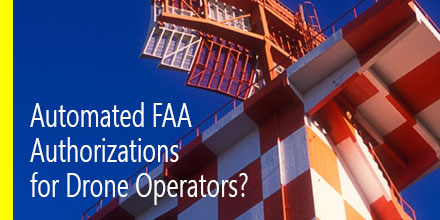 By the end of the year, several airports are expected to offer automated authorization for drone operators in controlled airspace. The rest of the nation’s airports will follow suit in 2018.
If successful, these automated authorizations will remove a significant barrier to the rapid expansion of commercial UAS operations.
Today, flights in controlled airspace, at certain times of day, or near sensitive locations require authorization from the FAA. Authorization requests can take up to 90 days and require labor-intensive manual approvals.
Today in
By the end of the year, several airports are expected to offer automated authorization for drone operators in controlled airspace. The rest of the nation’s airports will follow suit in 2018.
If successful, these automated authorizations will remove a significant barrier to the rapid expansion of commercial UAS operations.
Today, flights in controlled airspace, at certain times of day, or near sensitive locations require authorization from the FAA. Authorization requests can take up to 90 days and require labor-intensive manual approvals.
Today in  Drones have transformed a number of industries and services in addition to creating many new ones. The growth of drones is proof of how advancements in technology help perform certain tasks better and more efficiently.
Today, engineers are developing software that allows a swarm of drones to map areas affected by oil spills. Their work is inspired by the swarm and communication behavior of insects and birds.
However, given the very location of these disasters, surveying and mapping oil spills at sea or along coastlines is a difficult task. Accurately assessing the level of damage can be a tricky proposition. Researchers believe drones could provide a solution.
Just as ants converge in the thousands to find and carry food to their colony, engineers believe a swarm of low-cost drones could aid in the mapping of oil spills.
Drones have transformed a number of industries and services in addition to creating many new ones. The growth of drones is proof of how advancements in technology help perform certain tasks better and more efficiently.
Today, engineers are developing software that allows a swarm of drones to map areas affected by oil spills. Their work is inspired by the swarm and communication behavior of insects and birds.
However, given the very location of these disasters, surveying and mapping oil spills at sea or along coastlines is a difficult task. Accurately assessing the level of damage can be a tricky proposition. Researchers believe drones could provide a solution.
Just as ants converge in the thousands to find and carry food to their colony, engineers believe a swarm of low-cost drones could aid in the mapping of oil spills.
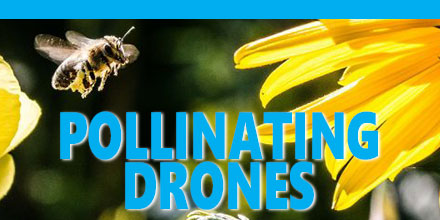 Pollinating Drones: Could Miniature UAVs save the World from Falling Bee Numbers? A number of scientists and drone developers are considering just that scenario.
For several years, scientist around the world have sounded the alarm over falling bee population numbers. Given their importance in the pollination of plants and crops, this is a cause for concern.
Scientists speculate that factors such as human activity and climate change have contributed to the steady decrease in pollinators.
But now researchers are proposing a radical new concept to tackle the troubling issue; tiny miniature drones as pollinators. Most of the world’s food supply comes from plants that require pollination. So, artificial pollinators may turn out to be an innovative and very important solution to securing it.
Pollinating Drones: Could Miniature UAVs save the World from Falling Bee Numbers? A number of scientists and drone developers are considering just that scenario.
For several years, scientist around the world have sounded the alarm over falling bee population numbers. Given their importance in the pollination of plants and crops, this is a cause for concern.
Scientists speculate that factors such as human activity and climate change have contributed to the steady decrease in pollinators.
But now researchers are proposing a radical new concept to tackle the troubling issue; tiny miniature drones as pollinators. Most of the world’s food supply comes from plants that require pollination. So, artificial pollinators may turn out to be an innovative and very important solution to securing it.
 Affordable, high-end drones coupled with easy-to-use mission-planning tools, created the perfect environment for drones to flourish.
No longer the preserve of specialists, applications using drones have ventured into survey, inspection and volume analysis.
The impact of drones is little short of revolutionary.
But, in the air, the stakes are higher. When things go wrong, the consequences are invariably much more serious than for a ground-based application. One of the biggest threats to drone safety is GNSS interference.
At the very least, disruptions to satellite signals can degrade position quality. When this occurs it causes fall-backs from high-precision RTK and PPP modes to less-precise modes. In the most extreme cases, interference can result in complete loss of signal tracking and positioning.
Affordable, high-end drones coupled with easy-to-use mission-planning tools, created the perfect environment for drones to flourish.
No longer the preserve of specialists, applications using drones have ventured into survey, inspection and volume analysis.
The impact of drones is little short of revolutionary.
But, in the air, the stakes are higher. When things go wrong, the consequences are invariably much more serious than for a ground-based application. One of the biggest threats to drone safety is GNSS interference.
At the very least, disruptions to satellite signals can degrade position quality. When this occurs it causes fall-backs from high-precision RTK and PPP modes to less-precise modes. In the most extreme cases, interference can result in complete loss of signal tracking and positioning.
 Figure 1 shows what happened to the GPS L1-band spectrum when a GoPro camera was installed on a quadcopter close to the GNSS antenna without sufficient shielding. The three peaks are exactly 24 MHz apart. This points to their being harmonics of a 24 MHz signal: the typical frequency for a MMC/SD logging interface.
An AsteRx4 receiver, which includes the AIM+ system, was selected for this setup. As well as mitigating the effects of interference, AIM+ includes a spectrum plot to view the RF input from the antenna in both time and frequency domains.
At the installation stage, the ability to view the RF spectrum is an invaluable tool for identifying the source of interference. Plus, it helps with determining the effectiveness of measures such as modifying the setup or adding shielding.
For the quadcopter installation in this example, the loss of RTK was readily diagnosed. The problem was solved by placing the camera in a shielded case. All this while the quadcopter was still in the workshop.
Figure 1 shows what happened to the GPS L1-band spectrum when a GoPro camera was installed on a quadcopter close to the GNSS antenna without sufficient shielding. The three peaks are exactly 24 MHz apart. This points to their being harmonics of a 24 MHz signal: the typical frequency for a MMC/SD logging interface.
An AsteRx4 receiver, which includes the AIM+ system, was selected for this setup. As well as mitigating the effects of interference, AIM+ includes a spectrum plot to view the RF input from the antenna in both time and frequency domains.
At the installation stage, the ability to view the RF spectrum is an invaluable tool for identifying the source of interference. Plus, it helps with determining the effectiveness of measures such as modifying the setup or adding shielding.
For the quadcopter installation in this example, the loss of RTK was readily diagnosed. The problem was solved by placing the camera in a shielded case. All this while the quadcopter was still in the workshop.
 Figure 2 shows how a 10mW chirp jammer can knock out RTK positioning over more than 1 km in a high-end receiver.
Even a low-end consumer-grade L1 receiver, being less accurate and thus less sensitive, loses stand-alone positioning over several hundred meters.
With AIM+ activated, the AsteRx4 is able to maintain an RTK fix throughout the simulated flight. It also shows no degradation to its position variance.
Figure 2 shows how a 10mW chirp jammer can knock out RTK positioning over more than 1 km in a high-end receiver.
Even a low-end consumer-grade L1 receiver, being less accurate and thus less sensitive, loses stand-alone positioning over several hundred meters.
With AIM+ activated, the AsteRx4 is able to maintain an RTK fix throughout the simulated flight. It also shows no degradation to its position variance.
